- Home
- Blog
- UI Developer
- MVC Interview Questions

- UI Developer Interview Questions
- UI and UX design trends to watch out for in 2024
- Full Stack Developer Interview Questions and Answers
- Software Design Interview Questions
- Low level Design Interview Questions
- LinkedIn Interview Questions
- Nagarro Interview Questions
- Web Development Projects and Use Cases
- How to Install Atom
ASP.NET MVC is an open-source program used to create modern applications with user interfaces. Its online development framework combines the characteristics of MVC (Model-View-Controller) architecture and techniques from the agile development platform.
We've put together a list of 50 top MVC interview questions and answers for the candidates to improve their knowledge and help ace the interview.Mindmajix experts curated the interview questions into three different sections:
Top 10 MVC Frequently Asked Questions
- Describe ASP.Net MVC?
- How does Spring MVC work?
- How does ASP.Net MVC's "page lifecycle" work?
- What are the various validator types?
- How is Ajax implemented?
- Which is more suitable, ASPX or Razor?
- Why should you use the PHP MVC Framework?
- What are MVC NonAction methods?
- What are Code Blocks in Views?
- Define Default Route in MVC?
MVC Interview Questions For Freshers
1. What is MVC?
MVC (Model-View-Controller) is a software design pattern used frequently to construct user interfaces, data, and controlling logic. It emphasizes the separation between the business logic and the appearance of the software. This "separation of concerns" allows for a more efficient division of labor and improved maintenance.
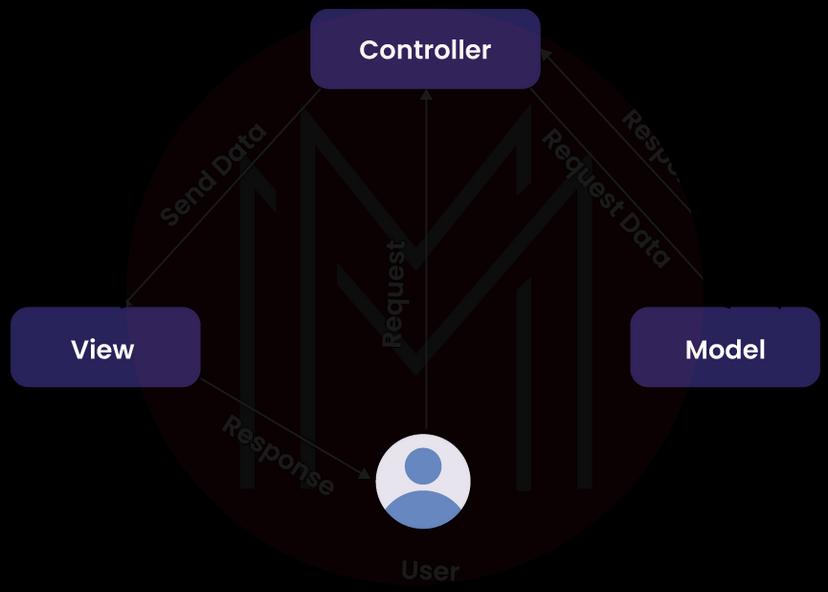
2. Identify the typical assembly in which the MVC framework is defined.
MVC framework is often defined in the System.Web.Mvc file.
| If you want to enrich your career and become a professional in FULL STACK, then enroll in "Full Stack Training" - This course will help you to achieve excellence in this domain. |
3. Describe ASP.Net MVC?
Microsoft's ASP.NET MVC is essentially a web development framework that combines the greatest elements of the pre-existing ASP.NET platform with the latest ideas and approaches from Agile development.
| Related Article: ASP.NET MVC Interview Questions |
4. Tell us about Asp.Net MVC's Model, View, and Controllers.
Model: It is a business entity used to represent the application data.
Controller: When a user sends a request, it always goes through the controller. The controller's job is to send the request to a specific view using the View() method.
View: It's the part of ASP.Net MVC that handles how things look.

5. Which MVC class do you use to send back the result in JSON format?
In any MVC application, you must add the "JSONRESULT" class to your application to send the result back in JSON format.
6. Can a session be maintained in MVC?
Yes, MVC supports session maintenance. Additionally, MVC session maintenance includes temporary data, a view bag, and view data.
7. How does Spring MVC work?
A Java framework called Spring MVC is used to make web applications. It uses the basic parts of a core spring framework, such as inversion of control and dependency injection, to follow the MVC design patteren.
| Related Article : MVC in iPhone |
8. What is the MVC Application life cycle?
MVC web application has two primary execution processes, first analyzing the request object and then sending an appropriate answer based on the request type. The two fundamental steps of the MVC application life cycle are creating the request object and transmitting the response to the browser.
Four fundamental stages are required to create the request object:
Step 1: Fill in the route first.
Step 2: Retrieve the route.
Step 3: Create a request context.
Step 4: Create a controller instance.
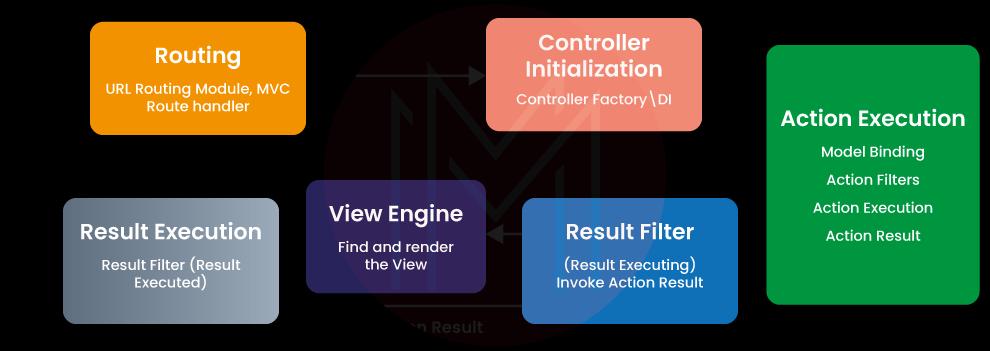
9. What are the various return types of a controller action method?
Return types of controller action methods include:
- Javascript Result
- View Result
- JSON Result
- Redirect Result
- Content Result
10. How does ASP.Net MVC's "page lifecycle" work?
ASP.Net MVC's "page lifecycle" works in the order:
- App initialization
- Routing
- Create and execute the controller
- Identify and implement a controller action
- Instantiate and render view.
11. What are some of MVC's advantages?
Some benefits of Model-View-Controller (MVC) are as follows:
- Testability
- More Control
- Lightweight
- Separation of Concerns (SOC)
- Change Accommodation
- Multiple view support
12. What exactly do MVC's Presentation, Abstraction, and Control layers do?
- Presentation: It is the application's visual representation of a specific abstraction.
- Abstraction: It is the feature of the application that deals with the business domain.
- Control: It is a part of the system that ensures uniformity between the internal abstraction and the user interface.
13. How can you add limits to a route in two different ways?
There are two options for imposing limitations on a route plan.
- Use of a component that supports the IRouteConstraint interface.
- Make use of pattern-matching phrases.
14. What is the order in which filters are run when more than one is used?
If you use multiple filters, the filter order will be as follows:
- Authorization filters.
- Action filters
- Response filters
- Exception filters.

15. What are the various validator types?
Various validator types are Range, Required, StringLength variety, and DataType.
MVC Interview Questions For Experienced
16. What exactly do you mean by Model Binding?
Model binding in MVC converts HTTP request data into parameters for action methods. To use the data in action methods, we must retrieve it from requests. The action method removes the repetitive work of obtaining data from HTTPRequest.

17. How is Ajax implemented?
Ajax can be implemented in MVC in two methods. They have listed below:
- Ajax libraries
- Jquery
18. How is error handling done in MVC?
Whether it's a Windows Forms application or a website, you may use exception handling to deal with MVC errors. The HandleError attribute aids in providing built-in exception filters and operates globally across action methods and controllers. You can override the Controller's "OnException" event. Set "Result" to the name of the View you wish to invoke when an error occurs.
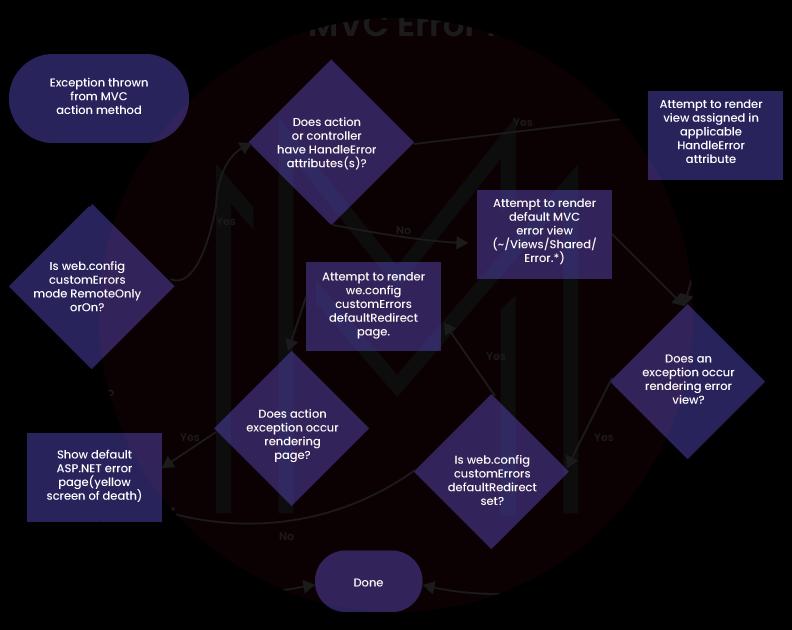
19. What is MVC Partial View?
A partial view is a piece of HTML that can be added to an existing DOM without causing problems. Most of the time, partial views are used to break up Razor views into their individual parts and make them easier to build and change. It can also be sent back from controller methods directly. In this case, the browser still gets text/HTML content, but not necessarily HTML content that makes up an entire page. So, an incomplete page may be shown if a URL that only gives a partial view is typed directly into a browser's address bar. This could be a page that needs a title, script, or style sheet.
20. How do "ActionFilters" work in MVC?
"ActionFilters" in MVC helps you run logic while an MVC action is being run or is running.
21. Which is more suitable, ASPX or Razor?
According to Microsoft, Razor is favored due to its lightweight nature and clear syntax.
22. What are the three most essential routing segments?
The three most important MVC routing segments are
- ActionMethodName.
- ControllerName.
- Parameter.
23. How are "ActionResult" and "ViewResult" different from each other?
"ActionResult" is an abstract class, and "ViewResult" is a class that is based on "AbstractResult." Some classes are based on "ActionResult," such as "JsonResult," "FileStreamResult," and "ViewResult."
If you are dynamically making different types of views, "ActionResult" is the best.
24. Explain ViewBag, ViewData, and TempData.
ViewBag: ViewBag is a Wrapper that goes around the ViewData. It is a dynamic property that uses the dynamic features of C# 4.0. Data does not have to be typecast before it is used, just like ViewData. ViewBag only has a life span from Controller to View.
Example: ViewBag.Message = "Test Data";
ViewData: ViewData is based on ViewDataDictionary, so it stores data in a key-value format like a dictionary. Keys are in String and represent the name of an object, while Values are objects. As the data in ViewData is stored as an object, it must be cast to its original type before it can be used. When getting data, you also have to do the NULL check. ViewData exists from the Controller to the View.
Example: ViewData["Message"] = "Test Data";
TempData: TempData is derived from the TempDataDictionary class and is also a Dictionary object consisting of Keys and Values, where Keys are Strings representing the object's name, and Values are objects. As the data is in object format, typecasting is required before using it and requires NULL checks during retrieval. TempData has a longer lifespan than ViewData and ViewBag. TempData can transmit data from the Controller to the View and the Controller to the Controller. Additionally, it is available for Current and Future Requests.
Example: TempData["Message"] = "Test temp data";
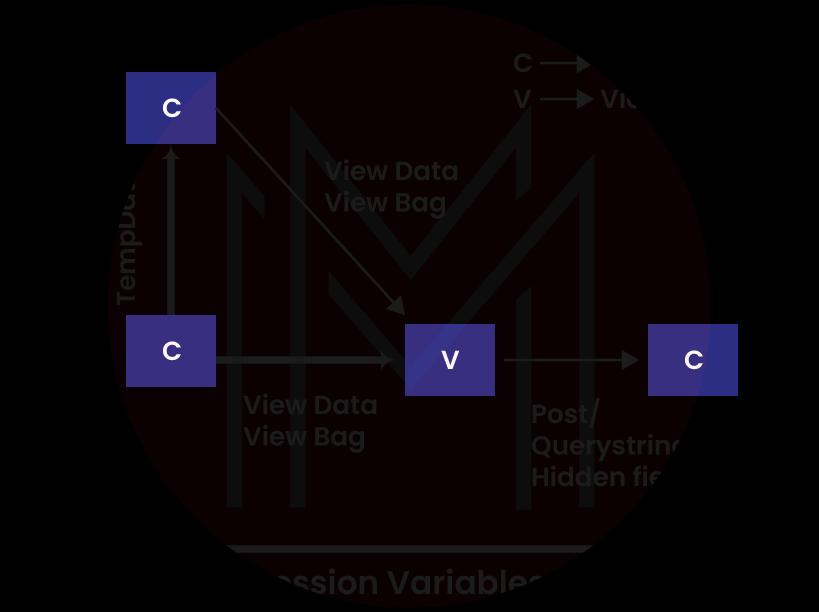
25. What is the significance of the default route {resource}.axd/{*pathinfo}?
The default route prevents the Controller from receiving requests for web resource files such as Webresource.axd or ScriptResource.axd.
26. What are the key considerations when developing an MVC application?
Here are some essential considerations to keep in mind when developing an MVC application:
- MVC application development strategy must be based on application requirements and ASP.net MVC features to suit specific development requirements.
- You must remember that ASP.net MVC is not replacing online forms-based ASP.Net applications.
- The separation of application tasks constantly improves the maintainability of an application.
- ASP.NET MVC application development is more sophisticated than online forms-based application development.
27. Why should you use the PHP MVC Framework?
You should use the PHP MVC Framework because it makes it easier to work with complex technologies.
- Providing standard methods for building our applications.
- Hiding all the intricate implementation details
- Compliance with professional coding standards
- Increased developer productivity as the foundational activities, such as sanitizing user input, connecting to the database, and so on, are already partially implemented.
28. Explain the Razor concept in ASP.NET MVC.
View engines, which are pluggable modules that implement different template syntax options, have always been a part of ASP.NET MVC.
The "default" view engine for ASP.NET MVC uses the same master file templates for.aspx,.ascx, and.master files as ASP.NET WebForms. Spart and Nhaml are two more view engines that come with ASP.NET MVC. The new view engine in MVC 3 is called Razor.
29. What are the various characteristics of MVC routes?
The MVC routes determine which controller method is run for a specific URL. Consequently, the URL has the following properties:
- URL Pattern: It is another property containing literal values and variable placeholders.
- Route Name: The URL pattern used to map the handler.
- Constraints: These are applied against the URL pattern to define the URL that matches it narrowly.
- Defaults: This is the default value given to the parameter when it was made.
30. What do you mean by MVC Scaffolding?
ASP.NET Scaffolding is a framework for building code for ASP.NET Web applications. When you wish to add code that interacts with data models quickly, you add scaffolding to your project. MVC Scaffolding can reduce the time it takes to build your project's standard data operations. Visual Studio 2013 comes with code generators for MVC and Web API projects that are already set up.
Advanced Level MVC Interview Questions And Answers
31. How can we tell whether a POST or GET request is made to an MVC controller?
The Request.HttpMethod property can be used, as demonstrated in the code snippet below, to determine if a call to the Controller is a GET action or a POST action.
public ActionResult SomeAction(){
if (Request.HttpMethod == "POST"){
return View("SomePage");
}
else{
return View("SomeOtherPage");
}
}32. What are MVC NonAction methods?
All public methods in MVC are treated as Actions. So, if you're writing a method and don't want to use it as an action method, you must decorate it with the "NonAction" attribute, as shown below.
[NonAction]
public void TestMethod(){
// Method logic
}33. How do we use a hyperlink to navigate from one view to another?
Using the ActionLink technique, navigation is possible. The code below will generate a simple URL that navigates to the "Home" controller and executes the Gotohome action.
<%= Html.ActionLink("Home","Gotohome") %>34. What is the Razor View Engine?
Razor Engine is a cutting-edge view engine introduced with MVC3. It is a new markup syntax and not a new language. Razor's new and enhanced syntax is short and expressive, decreasing the required type. Razor syntax is simple to learn and far more organized than Web Form syntax.
Razor encodes markup with the @ symbol as:
@Html.ActionLink("SignUp", "SignUp")
35. How may an alias be assigned to an ASP.NET Web API Action?
Using the "ActionName" feature, we can provide alias names for Web API actions in the same manner as ASP.NET MVC.
[HttpPost]
[ActionName("SaveStudentInfo")]
public void UpdateStudent(Student aStudent)
{
StudentRepository.AddStudent(aStudent);
}
36. What are the different kinds of results in MVC?
There are 12 different kinds of results in MVC. The "ActionResult" class is the main type, while the other 11 are subtypes of it. The list of these subtypes is as follows:
- EmptyResult
- ViewResult
- RedirectResult
- JavaScriptResult
- PartialViewResult
- RedirectToRouteResult
- JsonResult
- FileStreamResult
- FileContentResult
- ContentResult
- FilePathResult
37. What are Code Blocks in Views?
Code blocks are run instead of code expressions, which are evaluated and sent to the response. This is an excellent way to declare variables that we might need to use later.
38. What exactly is Spring MVC/Spring Web MVC?
With Spring MVC/Spring Web MVC, you can build web apps with an MVC architecture and pre-built components.
Spring MVC is a Java-based framework for developing web applications using the Model-View-Controller design pattern. It makes use of all of the fundamental characteristics of the Spring Framework.
Spring MVC has a dignified resolution for Spring Framework MVC implementation using DispatcherServlet.
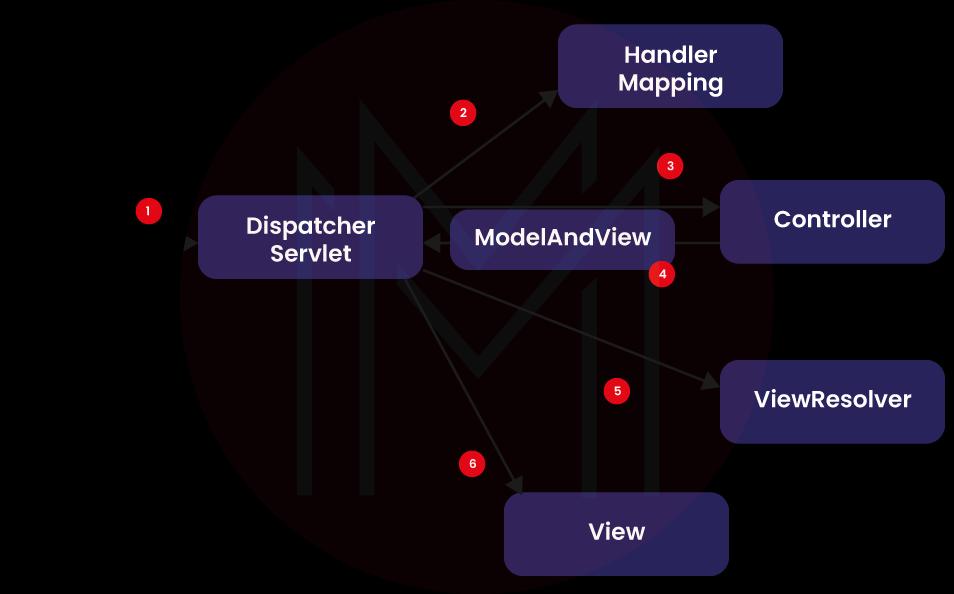
| Related Article : Spring Boot vs Spring MVC |
39. What are the uses of “beforeRender()”, “beforeFilter()”, and “afterFilter()” in Controller?
- beforeFilter(): This is executed before any controller action. It is used to validate permissions, user roles, and sessions.
- beforeRender(): It is called before the view is drawn and after the action logic of the controller is drawn. It may be needed if you call the render() function by hand before the end of a certain action.
- afterFilter(): It is invoked once rendering is complete and after each controller action. It's the last controller method that will be called.
40. Briefly describe your understanding of the separation of concerns.
Separation of Concerns is one of the basic elements and benefits of ASP.NET's MVC framework and is also one of its primary features. Here, the MVC framework clarifies concerns, including data, User Interface (UI), and business logic.
41. What exactly are MVC HTML helpers?
ASP.NET MVC includes the HtmlHelper class, which contains numerous methods for programmatically creating HTML controls. All HtmlHelper methods generate HTML and return a string as their return value. These functions build the final HTML at runtime. It is inappropriate to utilize the HtmlHelper class in controllers or models, as it is designed to produce user interfaces.
The list of Html Helper controls is below.
Html.Label
Html.Beginform
Html.TextArea
Html.Password
Html.CheckBox
Html.EndForm
Html.ListBox
Html.TextBox
Html.Hidden
Html.RedioButton
Html.DropDownList
42. What happens when an MVC error occurs?
The HandleError attribute is used, which helps provide built-in exception filters. Exception handling is usually used to handle errors, whether the app is a Windows Forms or web app. The HandleError attribute of ASP.NET can work on both the action method and the global level of the Controller.
43. List the file extensions that can be used with razor views.
Razor Views uses the following different file extensions:
- .vbhtml: When your MVC application is written in VB, that C language is used to write the code.
- .cshtml: When you use C# to write the code for your MVC application.
44. Why does MVC add Minification and Bundling?
Bundling and minification are two new techniques added to MVC whose primary goal is accelerating the request load time. It decreases the number of queries sent to the server and reduces the size of the requested item (JavaScript and CSS) to decrease the load time.
45. How does form authentication work in MVC?
Authentication is the process of granting users access to a specific service upon identity verification using a username and password. It ensures that the correct user is logged in for a particular service and receives outstanding service based on their role.
46. Define Default Route in MVC?
In MVC, the default Route of project templates includes a generic route that uses the given URL resolution to split the URL based on the request into three tagged segments.
URL: “{controller} / {action} / {id}”
47. What is the Entity Framework database-first approach?
The database-first approach to the Entity Data Model replaces the Code First and Model First approaches. It aids in creating a model class, as well as classes, DbContext, and properties to establish a connection between the database and the Controller.
48. How does the route pattern get registered?
Calling the MapRoute extension method of the RouteCollection registers the route pattern.
49. What is MVC Output caching?
When we want to improve the application's performance, we use output caching, which prevents duplicate content from being loaded by caching the content returned by the controller when the controller's methods are invoked. It is the best way to reduce database server round trips, server round trips, network traffic, etc.
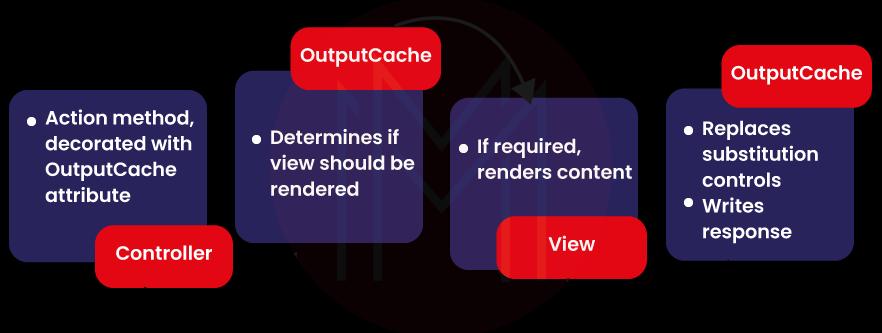
50. What are the various MVC View types?
MVC supports three types of views:
- User view
- Partial view
- Master page view
Most Common MVC FAQs
1. Is MVC front end or back end?
MVC offers the database, the user, and the data processing components with frontends and backends. The separation of front- and backend software systems streamlines development and separates maintenance.
2. What are the four major components of MVC?
The four major components of MVC are
- Models
- Routes
- Views
- Controllers.
3. What is the MVC life cycle?
MVC is actually made up of two life cycles:
- The application life cycle
- The request life cycle.
The application life cycle begins when the application process launches the server and ends when the server is shut down, and it marks the two events in your application's startup file.
4. How many types of MVC are there?
The three types of models in ASP.NET MVC are the domain model, the view model, and the input model.
5. What are the 3 layers of MVC?
The MVC model defines three logic layers for web applications:
- The business layer (Model logic)
- The display layer (View logic)
- The input lever (Controller logic)
6. Is MVC for the web only?
MVC was first made for desktop computers, but significant programming languages have since used it as a design for World Wide Web applications.
7. Which language is used in MVC?
The MVC pattern is used in many programming languages, including Java, Smalltalk, C and C++,.NET, Ruby on Rails, and others.
8. What is routing in MVC?
The ASP.NET Routing module is in charge of connecting requests from browsers to specific MVC controller actions.
9. What is the main use of MVC?
MVC is a software design pattern that is commonly used to implement data, user interfaces, and controlling logic.
10. What is an MVC real-life example?
WordPress is a real-life example of MVC. WordPress is not typically praised for its structure or code quality, but it has expanded rapidly because it is so simple to create a new theme.
11. What are filters in MVC?
Sometimes you want to do logic either before or after an action method. ASP.NET MVC has filters to help with this. Filters are custom classes that can add pre-action and post-action behavior to controller action methods. This can be done both declaratively and programmatically.
MVC Interview Preparation Tips
- You need to know what the interviewer wants before you can convince them to hire you. Fortunately, most companies list their requirements in the job posting. So review the MVC job description you saw before applying.
- Prepare intelligent answers to frequent MVC interview questions for the role.
- Answer questions that showcase your talents and enthusiasm in the position well.
- Keep your responses concise and targeted.
- Mock interviews are helpful here. They can simulate an interview and increase confidence.
- Choose formal interview dressing. Maintain your clothes clean and wrinkle-free.
- Speak confidently to the interviewer. Body language matters while talking to the HR interviewer.
- Maintain a modest smile to demonstrate confidence during the interview.
- Tell the interviewer if you don't know the answer. If you need time to ponder, ask the interviewer for a break.
Conclusion
To qualify in the most difficult MVC interviews, you must demonstrate your ability to think critically, develop clear solutions, and write clean and maintainable code, which you will learn by going through the top MVC interview questions and answers. Join our FULL STACK TRAINING courses to learn more and get expert tips on how to do well in an interview.
 On-Job Support Service
On-Job Support Service
Online Work Support for your on-job roles.

Our work-support plans provide precise options as per your project tasks. Whether you are a newbie or an experienced professional seeking assistance in completing project tasks, we are here with the following plans to meet your custom needs:
- Pay Per Hour
- Pay Per Week
- Monthly
| Name | Dates | |
|---|---|---|
| Full Stack Training | Jan 03 to Jan 18 | View Details |
| Full Stack Training | Jan 06 to Jan 21 | View Details |
| Full Stack Training | Jan 10 to Jan 25 | View Details |
| Full Stack Training | Jan 13 to Jan 28 | View Details |

Madhuri is a Senior Content Creator at MindMajix. She has written about a range of different topics on various technologies, which include, Splunk, Tensorflow, Selenium, and CEH. She spends most of her time researching on technology, and startups. Connect with her via LinkedIn and Twitter .















